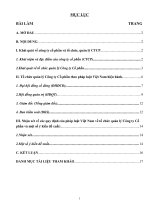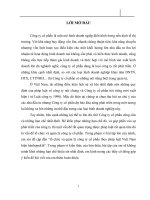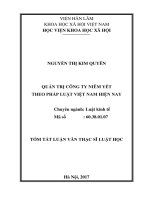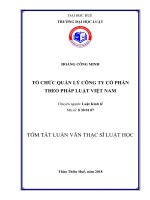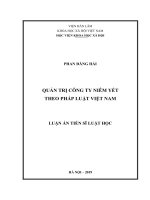Quản trị công ty niêm yết theo pháp luật việt nam tt tiếng anh
Bạn đang xem bản rút gọn của tài liệu. Xem và tải ngay bản đầy đủ của tài liệu tại đây (219.03 KB, 29 trang )
VIETNAM ACADEMY OF
SOCIAL SCIENCES
GRADUATE ACADEMY OF SOCIAL SCIENCES
PHAN DANG HAI
CORPORATE GOVERNANCE
FOR LISTED COMPANIES
BY VIETNAMESE LAW
Major: Economic law
Major Code: 938.01.07
ABSTRACT ON DOCTORAL THESIS
ON LAW
HANOI - 2019
The work is completed at:
GRADUATE ACADEMY OF SOCIAL SCIENCES
Supervisor:
1. Dr. Ho Ngoc Hien
2. Dr. Nguyen Van Tuyen
Opponency 1: ................................................................................................
Opponency 2: ...............................................................................................
Opponency 3: ................................................................................................
The Thesis will be protected before the Academy-level Thesis Review
Council which is met at Graduate Academy of Social Sciences
on .......... hour ………… minute, date …… month ……… .year ……
The thesis can be found at the library:
- National Library of Vietnam
- Information - Documentation Center - Library of Graduate Academy of Social
Sciences
LIST OF WORKS
DISCLOSURE OF THE AUTHOR
1.
Phan Dang Hai (2018), Some legal issues on preventing conflicts
of interest in corporate governance for listed companies, Journal
of Supervision No. 08/2018, P.36-41.
2.
Phan Dang Hai (2018), Development trend of the law on
corporate governance for listed companies and issues raised in
Vietnam, Law Journal No. 04/2018, August 2018, P.85-90.
3.
Phan Dang Hai (2019), Completing the law on corporate
governance for listed companies' Board of Directors, Law
Journal No. 01/2019, January 2019, P.52-55, 66.
1
PREAMBLE
1. The urgency of title
Since the nineteenth century, when the board of directors can make
decisions without the consent of all shareholders in the company, it causes
bankruptcy of many companies, corporate governance (CG) are firstly
concerned. The collapse story of Wall Street in 1929 was the clearest evidence,
starting the endless debate about the role of shareholders and managers,
ownership and control. The development trend as well as globalization appear
large-scale companies, in which, company owners are often not managers,
causing more difficult control. Conflicts of interest occur when shareholders owners realize that managers - representatives do not maximize the interests of
shareholders but only focus on increasing profits for themselves.
For listed companies, due to the important role derived from the
characteristics of scale as well as the level of influence on the stability and
sustainability of the whole economy, then CG plays a particularly important role.
The studies have shown that CG for listed companies is much more complicated
than conventional CG due to these issues, such as: diversified ownership
structure, asymmetric information, conditions for securities listing, information
disclosure regime and other regulations on the stock market are stricter.
In recent years, many legal documents have been issued in Vietnam, to
build the legal framework for CG activities such as: Securities Law 2006
(amended and supplemented in 2010), Enterprise Law 2014, Decree
71/2017/ND-CP on CG for public companies and Circular 95/2017/TT-BTC
guiding Decree 71/2017/ND-CP. According to general assessments, the
guarantee of law enforcement on CG not only still has many shortcomings, bu
also the application of new international practices that are only at the beginning.
There are many reasons for this situation; however, an essential problem is the
lack of completeness of legal regulations.
2
From the above reason, the PhD Student has selected the topic
"CORPORATE GOVERNANCE FOR LISTED COMPANIES BY VIETNAMESE
LAW" as research content for my doctoral thesis on Law.
2. Purpose and research task of thesis
2.1. Research purposes
The research purpose is to clarify theoretical and practical issues for law
on CG for listed companies in Vietnam on the basis of studying and learning the
legal experience of countries around the world, thereby proposing solutions to
improve Vietnamese law on CG for listed companies.
2.2. Research tasks
Firstly, in terms of theory, thesis systematizes and develops theoretical
issues of CG for listed companies and the law on CG for listed companies to
clarify the nature and characteristics of CG for listed companies, the subjects and
targets of CG for listed companies; analyzes the need to adjust by law for CG for
listed companies, the specific characteristics of law on CG for listed companies
in comparison with economic law and CG law in general, determines content of
the law on CG for listed companies and analyzes the factors affecting this legal
area.
Secondly, in practice, thesis analyzes, evaluates and compares current
Vietnamese law provisions regarding on CG for listed companies in order to
clarify the shortcomings and limitations in provisions of Vietnamese law on CG
for listed companies; gives data, collects cases of violations related to listed
companies to serve as evidence for scientific arguments in thesis.
Thirdly, thesis studies to propose views and solutions to improve the
effectiveness of law enforcement on CG for listed companies in Vietnam.
Fifthly, thesis researches the methods of developing and enforcing laws
as well as development trend of the law on CG for listed companies of countries
3
around the world to find out the experiences and development directions that
could be applied in Vietnam.
3. Subject and research scope of thesis
3.1. Research subject
Subject of research of the topic is the law on CG for listed companies,
specifically documents related to CG for listed companies, theoretical issues of
CG in general and CG for listed companies in particular, theoretical issues of the
law on CG for listed companies, the status of the legal regulations and situation
of enforcement of the law on CG for listed companies in Vietnam. During the
research process, laws of countries, especially the CG codes in the world are also
interested by the author. On that basis, thesis has drawn conclusions and
experiences for the process of improving the law on CG for listed companies in
Vietnam.
3.2. Research scope
About theory, thesis researches the views of corporate covernance, CG
for listed companies, and the current law on CG for listed companies in the
world, focusing on countries where CG theory and CG law has been developed.
About practice, thesis focuses on researching the status of the law on CG
for listed companies in Vietnam through the provisions of corporate law and
securities law. Besides, thesis has analyzed and commented on a number of legal
provisions of Germany, England, USA, Australia, Japan and the OECD's CG
Code to draw the necessary lessons for the process of building and improving
laws in Vietnam.
About time, thesis focuses on research on CG law for listed companies
since 2005 - the time when the concepts of CG were gradually formed in
Vietnam and the first legal documents appeared which directly adjusted the issue
of CG for listed companies.
4.1. Research methodology
4
The thesis is formed on the basis of the methodology of MarxismLeninism, Ho Chi Minh's thought and the Party's and State's views on improving
the market economy institution in the context of international integration. The
methodological basis of thesis is the dialectical materialism and historical
materialism.
4.2. Research Methods
To carry out the research tasks of thesis, the author has applied specific
research methods, suitable to each research content such as: Systematic, multidisciplinary and interdisciplinary approach to humanities and sciences; Methods
of analysis, logics, synthesis; Methods of analyzing legal logics; Historical,
collated and statistical methods; Method of law comparison.
5. New contribution on science of thesis
Firstly, thesis contains scholarly studies and the views of thesis author on
CG and CG for listed companies. The thesis has pointed out the characteristics
of CG for listed companies, analyzing the entities participating in the
relationship of CG for listed companies as well as the objectives of CG for listed
companies.
Secondly, thesis has built up the definition of the law on CG for listed
companies; at the same time, pointed out the characteristics of the law on CG for
listed companies compared with the economic law in general and CG law in
particular. The thesis has separated the basic law contents related to CG for
listed companies including the following issues: protecting shareholders' rights,
model of CG for listed companies, preventing conflicts of interest, report and
disclosure regimes, monitoring and handling violations.
Thirdly, with the research and evaluation of factors affecting the law on
CG for listed companies and the development trends of the law on CG for listed
companies and practices in the world, thesis has clarified the practical basis for
establishing policies for CG for listed companies activities, enriching Vietnam's
5
legislative thinking in promulgating legal regulations on governing this activity.
This is an important premise as a basis for building and perfecting the
regulations on CG for listed companies in Vietnam in the future.
Fourthly, thesis has analyzed and systematically assessed the status of the
law on CG for listed companies in Vietnam, showing the advantages and
disadvantages in the regulations and mechanisms for implementing those
regulations. In the process of analysis and evaluation, thesis compares
Vietnamese law with foreign laws and international practices to obtain objective
and scientific judgments.
Fifthly, thesis has identified the requirements in perfecting the law on CG
for listed companies; proposed recommendations to improve the contents of law
and solutions to improve the effectiveness of law enforcement on CG for listed
companies.
6. The theoretical and practical significance of the thesis
Until the present time, thesis is the first research project at a Doctorallevel thesis that has studied thoroughly both theoretical and practical issues of
the law on CG for listed companies.
The thesis is a reference source for university students, legal scientific
researchers, academic managers and policy-making and law issuance of
Vietnam.
7. Structure of thesis
In addition to the introduction, conclusions, appendices and lists of
references, thesis consists of 4 chapters:
Chapter 1: Overview of research situation.
Chapter 2: Theoretical issues about CG for listed companies and the law
on CG for listed companies.
Chapter 3: Actual situation of the law on CG for listed companies in
Vietnam.
6
Chapter 4: Perfecting the law on CG for listed companies in Vietnam
today.
Chapter1
OVERVIEW OF RESEARCH SITUATION
1.1. Overview of research situation related to the title
Through the study of research projects related to the title, the author has
synthesized the research work into 3 groups: i) Theoretical research works on
CG for listed companies; ii) Legal research works on CG for listed companies;
iii) Research works on the status of the law on CG for listed companies in
Vietnam. Since then, the author has learned some conclusions as follows:
Firstly, the research results that thesis will inherit and continue to
develop
- Theoretical issues related to CG, specifically: i) Definition of CG:; ii)
Role of CG; iii) Factors affecting CG.
- Domestic and international projects under the perspective of Law have
built the basic contents of the law on CG for listed companies in Vietnam.
- Domestic and international researches have shown many challenges in
developing CG law in general and the law on CG for listed companies in
particular in Vietnam in the coming time.
- Domestic research projects, under the Law, have pointed out the
inadequacies that need to be overcome in the current situation of CG law in
general and CG law for listed companies in particular as well as made solutions
to overcome these shortcomings.
- Because there are many research projects carried out from the economic
perspective, technical and professional issues in CG are generally analyzed and
evaluated quite specifically and thoroughly.
7
Secondly, thesis needs to continue research the issues which have not
been thoroughly solved
- About the approach: The studies which have been carried out often
approach in a single discipline in terms of economics, sociology or law.
Although there are also some studies that have access to multi-disciplinary
economic - sociological studies, a research selecting the approach of law economics - sociology has not yet been implemented.
- About theory: Currently, there has not been a comprehensive research
on theoretical aspects of CG for listed companies and the law on CG for listed
companies.
- About practice: The research works mainly focus on the current status
of CG law. Some works also refer to the current status of the law on CG for
listed companies in Vietnam, whether it is general research or small contents,
most of them are based on legal documents which have expired presently.
- About complete solutions: Due to the lack of comprehensive, direct and
updated researches related to the law on CG for listed companies, the solutions
to improve the regulatory framework for CG for listed companies has not been
performed by the research.
1.2. Basis of theoretical research
1.2.1. Agency Theory
In The Wealth of Nation, Adam Smith (1776), for the first time, poses the
fundamental challenge behind all the issues of CG, that is an Agency. Jensen and
Meckling (1976) explain as following: Agency theory relates to a contract,
whereby one or several people (shareholders) assign other people (members of
the Board of Directors) to perform some services on their behalf, including
authorization to issue decisions. If in this relationship, both parties are people
who want to maximize benefits, we have reason to believe that representatives
will not always act for the benefit of the owner.
8
1.2.2. Stewardship Theory
Davis and Donaldson (1991) argue that managers who are considered as
good ones in governance will work for the best of shareholders. These members
of the Board of Directors will then be managers, or steward for their benefit. The
members of the Board of Directors report to shareholders on the results of such
management as a responsibility of the manager for interests of shareholders. The
belief that being able to trust in a member of the Board of Directors is an
inherent belief in the concept of a company.
1.2.3. Stakeholder Theory
Stakeholder theory is developed by Freeman (1984) with the content of
corporate responsibility with the company's stakeholders, including individuals
and organizations with certain concerns or interests with the company: owners,
staffs (employees), trade unions and external audiences such as lenders,
suppliers, customers, communities and society. According to theory of
stakeholders, the company is a system of stakeholders operating in a large
system of society.
1.2.4. Resource Dependence Theory
This theory considers the CG section of corporate entities as a pin
between the company and resources that the company needs to achieve its goals.
These resources can be connectors to relevant markets including customers and
potential competitors, opportunity to access to capital and other financial
resources, business know-how provisions and technology, and relationships with
networks and other business, political and social actors.
Four main theories about CG show many approaches in building CG law:
i) With Agency theory, the law should focus on monitoring Stewardship and
Executives, to ensure that they operate company for shareholders' benefits; ii)
Stewardship theory focuses on helping and empowering Stewards and
Executives, thereby creating the most effective CG, at the same, time, upholding
9
the responsibility of "cautious, sincere, honest ” of the Stewards; iii) With
Stakeholder theory, the law should set out requirements in the governance
structure that must include parties with interests related to the company, with the
aim of ensuring that the company operates for the benefits of these stakeholders
...
In short, when researching on CG in general and CG for listed companies
in particular, it is necessary to review under the points of view of many different
theories to ensure the most general and comprehensive aspect. Based on this
theory, the author can better understand the nature of CG, thereby creating a
premise to build the characteristics of CG for listed companies, characteristic of
the law on CG for listed companies, as well as making requirements in
completing the law on CG for listed companies in Vietnam.
Chapter 2
THEORETICAL ISSUES ABOUT CORPORATE GOVERNANCE FOR
LISTED COMPANIES AND THE LAW ON CORPORATE
GOVERNANCE FOR LISTED COMPANIES
2.1. Theoretical issues on corporate governance for listed companies
2.1.1. Concept about listed companies
A listed company is a public company whose shares are listed at the Stock
exchange or the Securities trading center. In order to recognize the listed
company, in addition to the general characteristics of a common joint stock
company, the listed company also has some specific characteristics as follows: i)
Listed company have listed shares traded on Stock exchanges or Securities
trading centers; ii) Listed company have a more complicated internal
organizational structure than joint stock company; iii) Listed company are
subject to corporate law and securities law; iv) Listed company are under the
management of the Stock exchange and the State Securities Commission.
10
2.1.2. Perspectives on corporate governance
In a narrow sense, CG is understood as a regime for internal
management of the company, reflecting the relationship between shareholders
and the Board of Management, the Board of Directors. This idea comes from a
long-standing problem of CG - an Agency issue.
In the broad sense, CG is a system of regulations and mechanisms that
enable company to attract capital, operate effectively, achieve company goals,
meet the requirements of law and general expectations of society. Accordingly,
CG determines the responsibilities and rights of the stakeholders, such as
shareholders, general meetings of shareholders, the Board of Management, the
Board of Directors and other related persons of the company, at the same time,
set up principles and procedures to make decisions about the problems of the
company.
With the two above understandings about CG, the author agrees with the
understanding of CG in a broad sense with the reason that modern CG is not
merely handling internal relationships, but also dealing with the relationships
arisen between the company and those related to benefits of the company.
2.1.3. Concept of corporate governance for listed companies
CG for listed companies is the system of regulations, mechanisms
including: laws, listing regulations, aimed-at-orientation voluntary practices,
operation and control of listed companies. The CG for listed companies reflects
the relationship between shareholders, the Board of Management, the Board of
Directors and stakeholders through identifying the management and
organization structure of the listed company, as well as the goal-setting process,
determining the means to achieve goals and effectively monitor the performance
of company goals for the benefit of shareholders and corporate stakeholders.
From the above definition, CG for listed companies has some of the
following characteristics: i) CG for listed companies is a system of regulations,
11
mechanisms that reflect relationships, determined by the structure and processes;
ii) The relationships in CG for listed companies related to the parties have
different interests, sometimes they are conflicting interests; iii) CG for listed
companies involves orientation and control of the company on the basis of
appropriately allocating rights and responsibilities - and thereby balancing
benefits.
2.1.4. Subjects participating in relations of corporate governance for
listed companies
The entities involved in CG for listed companies are individuals or
organizations that have certain positions and roles in CG for listed companies.
Within the internal affairs of joint stock company in general and the listed
company in particular, there are three most essential entities corresponding to 3
levels of control in the CG relationship, that is: Shareholders, Board of
Management and Board of Directors. Besides, due to the large number of
investors in the listed company, in addition to the multi-tier management
apparatus, some countries often stipulate that it is required to organize the
Supervisory Board to protect the interests of investors.
In addition to the entities within the company, many other entities
participate in the relationship of CG for listed companies as the parties with
interests related to the company: not only creditors, investors, but also
employees, suppliers, customers, law agencies, government authorities and local
communities where the Company operates.
2.1.5. The goals of corporate governance for listed companies
CG for listed companies is considered successful when the following
objectives are achieved:
Firstly, ensure the adaptability of the CG system. This goal aims to ensure
a CG environment in consistent with social values and create long-term
economic returns.
12
Secondly, increase the value and protect rights of shareholders. CG must
firstly create long-term economic profits to increase shareholder value
(investors) in order to attract capital in the context of global competition on
capital.
Thirdly, regulate the interests of stakeholders. The success of the
effective governance framework is associated with the ability to regulate
interests between the Board of Directors, the Directors and stakeholders with the
interests of shareholders.
Fourthly, increase the independence of the Board ò Directors and
control mechanisms. The Board of Directors and other control mechanisms are
responsible for protecting and combating deception, wasteful assets or
ineffective operations of the Board of Directors or managers.
2.2. Theoretical issues about the law on corporate governance for
listed companies
2.2.1. The need on adjustment by law to relations of corporate
governance for listed companies
The adjustment by law for CG for listed companies relations is really
necessary from the following main reasons: i) CG in general and CG for listed
companies in particular have a very important role, greatly affecting the socioeconomic life. The law on CG for listed companies is born and developed to
meet that demand; ii) Derived from the incomplete nature of the contract in the
relationship of CG in general and CG for listed companies in particular; iii) CG
law for listed companies creates a legal corridor for the development of CG for
listed companies, ensuring the interests of parties in the relationship of CG for
listed companies.
2.2.2. Concept of the law on corporate governance for listed companies
The law on CG for listed companies is a system of legal regulations
governing social relations arisen from the relationship between shareholders,
13
the Board of Management, the Board of Directors and other stakeholders in the
process of orientation, operation and control of the company to achieve certain
goals.
We can draw some characteristics of the law on CG for listed companies
as follows:
Firstly, the law on CG for listed companies has the common
characteristics of economic law: i) Recognize the parties' self-determination
right on participating in property relations; ii) Basic rules are the ones explaining
the will of parties in relationships.
Secondly, in addition to the general characteristics, the law on CG for
listed companies has a number of specific characteristics to distinguish it from
the economic law and CG law: i) Subjects and objectives of the law on CG for
listed companies: Subjects of the law on CG for listed companies include both
internal affairs of companies and other individuals and organizations related to
the company. The law on CG for listed companies is aimed at ensuring the rights
of stakeholders; ii) Adjustment method of the law on CG for listed companies:
The law on CG for listed companies is much stricter than the regular CG law; iii)
The nature of legal regulations of CG for listed companies: The law provisions
of CG for listed companies can be divided into 3 types: the provisions with
absolutely compliance, provisions with relative compliance (compliance or
explanation), provisions with proposal nature; iv) Structure of the law on CG for
listed companies includes: general law, specialized law, regulations and other
rules of CG for listed companies.
2.2.3. The basic contents of the law on corporate governance for listed
companies
From the approach of the law on CG for listed companies under the
groups of issues, the basic contents of the law on CG for listed companies
include: i) Legal regulations on protecting shareholder rights; ii) Legal
14
regulations on models of CG for listed companies; iii) Legal provisions on
preventing conflicts of interest; iv) Legal regulations on report regime and
announcement of information; v) Legal regulations on supervision and handling
of violations.
2.2.4. Factors affecting to the law on corporate governance for listed
companies
Factors affecting to the law on CG for listed companies are important
prerequisites to the formation and development of the law on CG for listed
companies in countries as well as in Vietnam, including: i) National economic
management mechanism; ii) National socio-economic conditions; iii) Supporting
institutions for CG law; iv) The trend of international economic integration.
2.2.5. Development trend of the law on corporate governance for listed
companies in the world and the arisen issues for Vietnam
Determine theory of CG for listed companies: Regarding the purpose of
the company, the world also appears two theories with two opposing points of
view; namely, shareholder value theory and stakeholder value theory. Basically,
the current regulations on CG for listed companies in Vietnam have not clarified
the purpose of the company. Only on the basis of determining what the purpose
of company is, the new legal framework for CG for listed companies can be built
in a consistent and unified way.
Develop a model of CG for listed companies: When researching the
governance model of joint stock companies around the world, there are two
basic models: dual board or two-tier board model and unitary board or one-tier
board model. The organization according to which model depends on the
actual and traditional conditions, the legal mechanism of each country. In
Vietnam today, there are two CG models that listed companies can choose. No
matter which model exists, the problems in any country are: i) Clearly define
the authority of each agency in the CG for listed companies model; ii) Increase
15
quality of the company's managers, executives and supervisors; iii) Facilitate
supervisory entities to fulfill their assigned responsibilities
Receive the CG Codes for listed companies: System of regulations related
to CG for listed company includes formal and informal regulations. In essence,
the CG Codes for listed companies of international organizations and countries
are non-legal guidelines for the purpose of supplementing laws and other
regulations of the law on CG. In the context of the current legal environment of
Vietnam, the Enterprise Law and the Securities Law only provide the basic
principles of CG for listed companies, we should strengthen the legal framework
on CG for listed companies by the development of guiding documents,
especially the CG Codes applied to listed companies in a manner in consistent
with the OECD CG Principles.
Chapter 3
ACTUAL SITUATION OF THE LAW ON CORPORATE
GOVERNANCE FOR LISTED COMPANIES
IN VIETNAM
3.1. Actual situation of the legal content on corporate governance for
listed companies in Vietnam.
The legal framework regulating CG for listed companies in Vietnam is
divided into three groups with the following major legal documents:
Firstly, general law group includes the following documents: Enterprise
Law 2014; 2015 Accounting Law and 2013 Independent Auditing Law; The
Civil Code 2015 and other Laws are the basis for CG in relation to stakeholders.
Secondly, specialized law group including the following documents:
Securities Law 2006 (amended and supplemented in 2010); The documents
under the Law are Decree 71/2017/NĐ-CP on CG for public companies;
16
Circular 95/2017/TT-BTC guiding Decree 71/2017/NĐ-CP on CG for public
companies; Circular 155/2015/TT-BTC on information disclosure on the stock
market.
Thirdly, group of regulations and rules of other CG for listed companies:
scattered in Decree 71/2017/NĐ-CP and Circular 95/2017/TT-BTC with the
principles and recommendations in activities of CG for listed companies.
3.1.1. Current status of legal regulations on protecting shareholder
rights
Through the research of current regulations, the thesis found that the basic
rights of shareholders of listed company have been fully recognized,
emphasizing on 3 important issues: control of company, rights to ensure fairness
and rights to protect its legal rights. Although there are still inconsistencies
related to the determination of minority shareholders, the rights to derivative
litigation, the associated mechanism to form a group of shareholders..., we could
consider the regulation on shareholder rights has a certain improvement, creating
conditions for shareholders to use to protect themselves in practice.
3.1.2. Current situation of legal regulations on model of company
governance of listed company
About the two CG for listed companies models: The Enterprise Law has
enabled companies to be more flexible in management, increasing the
responsibility for shareholders in changing social and business environments.
However, the current limitation is that there are not many specific regulations or
guidelines for the CG model, especially for listed companies when making the
same requirements even though the two models have quite a lot of different
points.
About General Meeting of Shareholders: In general, Vietnamese law on
functions, roles and duties of the General Meeting of Shareholders is consistent
with Agency theory and has many similarities with international practices.
17
Aboutthe Board of Directors: Due to play an important role in the
company, the legal regulations give much attention to the Board of Directors,
especially for listed companies. Regulations relating to membership ofthe
Boards of Directors, number and structure of members in the Boards of
Directors, meeting of the Boards of Directors, subcommittees belonged to the
Board of Directors have been fully regulated, closely to international practice.
However, some important roles of the Board of Directors such as establishing
corporate culture and business ethics have not been recognized; the standards of
the independence of the independent members of Board of Directors are still
incomplete.
About Supervisory Board: In generally legal regulations, powers and
responsibilities and activities of the Supervisory Board in listed companies are
relatively clear and reasonable. However, the current legal provisions just stop at
regulating the rights and obligations but not paying attention to the legal
mechanism to implement those rights and obligations as well as sanctions to deal
with the possible violations.
About the legal representative: A listed company may have one or more
legal representatives, subject to the provisions of the company's ruler. However,
the current legal regulations do not have a specific mechanism if the company
has more than one legal representative.
3.1.3. Situation of legal regulations on preventing interests conflict
Preventing interest conflicts through manager responsibilities of
enterprise: In addition to the advantage of clearly defining the responsibilities of
business managers, Vietnamese laws currently have still shortcomings in the
delineation of those who are business managers. The concept of enterprise
managers in accordance with current Vietnamese law when compared with
international practice, especially with the laws of some countries in the Common
law family, also reveals many limitations.
18
Preventing interest conflicts by controlling unusual transactions of
company: Unusual transactions are those that greatly affect the company's
business, company value, stock price and property rights, which can be high
value transactions or the ones with related people of the company. Some
shortcomings still exist in the legal regulations on this issue are: i) Regulations
on identifying related persons do not cover all objects to be controlled in order to
prevent risky of self-interest transactions in the company; ii) Regulations on
controlling the value of transactions are not clear and revealing many
limitations; iii) The application of the necessary measures to prevent benefit
losses focuses on the interests of company.
3.1.4. Current status of legal regulations on report and information
disclosure regimes
Information and methods of information disclosure in accordance with
Vietnamese law are relatively clear, which makes information disclosure
possible, ensuring shareholder's and punlic's equal access.
3.1.5. Status of regulations on supervision and handling of violations
The State Securities Commission is the subject responsible for
supervising the contents related to the CG for listed companies. Sanctions are
mainly applied to violations of the law on CG as administrative sanctions. With
a small fine, deterrence for violating businesses and individuals is not high.
Meanwhile, the possible consequences, including affecting investors' rights due
to inadequate access to information, may affect to stock prices , losing
confidence about the company.
Summary, Vietnam's legal framework on CG for listed companies has
been basically guaranteed. The legal regulations of the CG for listed companies
has met the rigorous requirements of CG for listed companies by setting
conditions higher than the general CG regulations. In addition, the Vietnamese
law has recently made great steps in approaching international standards on CG,
19
reflected in international requirements, principles and standards of CG, which
has gradually been legalized in Vietnam's legal documents. However, the legal
framework on CG for listed companies still has many shortcomings related to
the structure and management model, functions, tasks and authority of internal
agencies, protection mechanisms rights and interests of shareholders,
mechanisms to control and prevent potential conflicts of interests, transparency
and information disclosure ...
3.2. Actual situation of law enforcement on corporate governance for
listed companies in Vietnam.
3.2.1. The achievements
In the recent years, the implementation of laws and good practices of the
CG has been significantly improved in a more open and transparent manner. To
achieve this success, a bright spot is easy to see that listed companies begin to be
aware of the responsibility and necessity of CG and have made certain efforts. In
addition, the activities of assessing the implemented regularly operations CG
have brought positive results .
3.2.2. Restrictions, shortcomings
About protecting shareholder's rights: A prominent issue in CG for listed
companies is the actual rights of shareholder are often violated. The form of
violation is expressed mainly in two forms: i) Violation of fundamental rights of
shareholders; ii) Violation of fair treatment among shareholders. The trend of
violating the interests of shareholders and the equal treatment of shareholders is
increased continuously. Forms of violations of shareholders' rights are
increasingly complicated and difficult to detect.
About the Boards of Directors: In general, the conditions and standards of
the Board of Directors and members of the Board of Directors have not been
ensured, the performance of the Board of Directors is not high, the independence
of the Board of Directors is sometimes only formalistic.
20
About the Supervisory Board: Although it is the agency that performs the
role of internal monitoring and control; directly supervising the Board of
Management and the Board of Directors according to the law, however; in fact,
many assessments believe that the Supervisory Board in listed companies has
not fully played its role. Sometimes, the Supervisory Board is also taken as a
support force, standing behind and abetting the Board of Directors, the Director
(General Director) to carry out acts harmful to shareholders' interests.
About information disclosure regime: Based on the survey reports, it can
be said that the compliance situation on information disclosure obligations on
the stock market in recent years has been still very limited when the percentage
of listed companies completing correctly and fully information disclosure is not
much. Among the cases where information disclosure standards are not met, the
common violations are: i) Violations related to the disclosure of financial
statements; ii) Violations related to the meetings of General Meeting of
Shareholders; iii) Violations related to the publication of the CG Report.
In short, the problems of CG for listed companies in Vietnam are from
the following main causes:
Firstly, historical factors, business culture: The appearance of controlling
shareholders is the State and the structure of centralized ownership shares. From
the influence of history and business culture in Vietnam, the fact that the CG for
listed companies has raised the following problems: i) There is little division
between ownership and management rights; ii) Loose control mechanism; iii)
Lack of publicity and transparency in CG:
Secondly, law construction activities: The requirement of completing the
law also leading to the problem is the legal regulations are built towards
progress, approaching international practices, creating a very long distance
between legal provisions and operation ability of listed companies. In addition,
the law on CG for listed companies still exists inadequacies, which creates
21
conflicts and overlaps in the system, appearing difficulties in the process of
enforcement of CG for listed companies.
Thirdly, activities of agencies and organizations related to CG for listed
companies: competent state agencies have not clearly demonstrated the role as
well as effectiveness in the supervision and enforcement of law enforcement of
listed companies; lack of existence and participation of intermediary
organizations to support CG.
Fourthly, awareness of listed companies for CG activities: general
awareness on CG for listed companies is still limited; Many cases are from the
lack of a sense of respecting for CG law for listed companies.
Chapter 4
PERFECTING THE LAW ON CORPORATE GOVERNANCE FOR
LISTED COMPANIES IN VIETNAM TODAY
4.1. The requirements of perfecting the law on corporate governance
for listed companies in Vietnam in the current period
Firstly, ensuring constitutionality, legality and consistency in the legal
system, especially between the Enterprise Law, Securities Law and Decree
71/2017/NĐ-CP.
Secondly, respect the company's business autonomy.
Thirdly, ensure flexibility and suitability for business environment.
Fourthly, ensure fairness and harmony of the interests of all stakeholders
to CG.
Fifthly, ensure transparency and efficiency.
Sixthly, ensure compatibility with the law and good practices in the world
on CG for listed companies on the basis of socio-economic conditions in
Vietnam.
22
4.2. The solutions to perfect the law on corporate governance for
listed companies in Vietnam today
4.2.1. General solution to perfect the legal framework of corporate
governance for listed companies in Vietnam
Firstly, synchronously completing the provisions of the 2014 Enterprise
Law and related documents to create a basic legal framework for CG activities in
general and CG for listed companies in particular.
Secondly, completing the provisions of Securities Law 2006 (amended
and supplemented in 2010), Decree 71/2017/NĐ-CP and guiding documents
with the aim of ensuring consistency and consistency with the Law on
Enterprises in the legal framework of CG for listed companies; amending,
supplementing and detailing regulations to ensure feasibility and efficiency in
the implementation of the law on CG for listed companies; amending and
supplementing regulations on CG for listed companies in specific cases;
continuing to institutionalize OECD's principle issues and good CG Code for
listed companies in the world into legal documents in Vietnam.
Thirdly, aiming to issue a proper CG Code applicable to listed companies
in order to complete the framework of CG regulations for Vietnam's stock
market. It needs to specify which content should be legalized, what should be
specified in the CG Code for listed companies.
4.2.2. Recommendations to perfect the content of the law on Corporate
governance for listed companies in Vietnam
About
protecting
shareholder's
rights:
Modify
and
supplement
regulations: i) rate of holding common shares of shareholders to exercise the
right to nominate candidates to the Board of Directors, Supervisory Board; ii)
the share ownership ratio of shareholders to exercise the right to sue against
members of the Board of Directors, Director (General Director); iii) a

